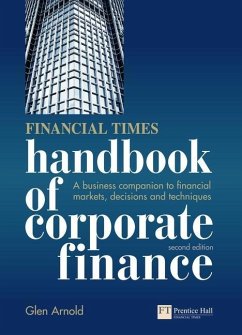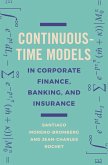Glen Arnold
Financial Times Handbook of Corporate Finance, The
A Business Companion to Financial Markets, Decisions and Techniques
Glen Arnold
Financial Times Handbook of Corporate Finance, The
A Business Companion to Financial Markets, Decisions and Techniques
- Broschiertes Buch
- Merkliste
- Auf die Merkliste
- Bewerten Bewerten
- Teilen
- Produkt teilen
- Produkterinnerung
- Produkterinnerung
Mangers working in business find that the further they progress, the more they need to understand the concepts and jargon of the business world. This book introduces the principles and practices of corporate finance and the financial markets. It identifies the following key financial knowledge that the reader will require: . An explanation of value-based management. . Mergers and the problem of merger failures. . The use of derivatives in helping businesses control risk. . Investment appraisal techniques. . How the financial markets work. . Enhancing shareholder value. . Raising capital for your company.…mehr
Andere Kunden interessierten sich auch für
![Corporate Finance, Global Edition Corporate Finance, Global Edition]() Jonathan BerkCorporate Finance, Global Edition75,99 €
Jonathan BerkCorporate Finance, Global Edition75,99 €![Continuous-Time Models in Corporate Finance, Banking, and Insurance Continuous-Time Models in Corporate Finance, Banking, and Insurance]() Santiago Moreno-BrombergContinuous-Time Models in Corporate Finance, Banking, and Insurance60,99 €
Santiago Moreno-BrombergContinuous-Time Models in Corporate Finance, Banking, and Insurance60,99 €![Principles of Managerial Finance, Global Edition Principles of Managerial Finance, Global Edition]() Chad J. ZutterPrinciples of Managerial Finance, Global Edition116,99 €
Chad J. ZutterPrinciples of Managerial Finance, Global Edition116,99 €![Fundamentals of Multinational Finance, Global Edition Fundamentals of Multinational Finance, Global Edition]() Michael MoffettFundamentals of Multinational Finance, Global Edition94,99 €
Michael MoffettFundamentals of Multinational Finance, Global Edition94,99 €![Multinational Business Finance, Global Edition Multinational Business Finance, Global Edition]() David EitemanMultinational Business Finance, Global Edition60,99 €
David EitemanMultinational Business Finance, Global Edition60,99 €![Mathematics for Finance, Business and Economics Mathematics for Finance, Business and Economics]() Irenee DondjioMathematics for Finance, Business and Economics77,99 €
Irenee DondjioMathematics for Finance, Business and Economics77,99 €![Monetary Policy, Islamic Finance, and Islamic Corporate Governance Monetary Policy, Islamic Finance, and Islamic Corporate Governance]() Monetary Policy, Islamic Finance, and Islamic Corporate Governance125,99 €
Monetary Policy, Islamic Finance, and Islamic Corporate Governance125,99 €-
-
-
Mangers working in business find that the further they progress, the more they need to understand the concepts and jargon of the business world. This book introduces the principles and practices of corporate finance and the financial markets. It identifies the following key financial knowledge that the reader will require: . An explanation of value-based management. . Mergers and the problem of merger failures. . The use of derivatives in helping businesses control risk. . Investment appraisal techniques. . How the financial markets work. . Enhancing shareholder value. . Raising capital for your company.
Hinweis: Dieser Artikel kann nur an eine deutsche Lieferadresse ausgeliefert werden.
Hinweis: Dieser Artikel kann nur an eine deutsche Lieferadresse ausgeliefert werden.
Produktdetails
- Produktdetails
- Verlag: Pearson Education Limited
- 2 ed
- Seitenzahl: 816
- Erscheinungstermin: 2. September 2010
- Englisch
- Abmessung: 243mm x 172mm x 45mm
- Gewicht: 1318g
- ISBN-13: 9780273726562
- ISBN-10: 0273726560
- Artikelnr.: 28382637
- Herstellerkennzeichnung
- Libri GmbH
- Europaallee 1
- 36244 Bad Hersfeld
- gpsr@libri.de
- Verlag: Pearson Education Limited
- 2 ed
- Seitenzahl: 816
- Erscheinungstermin: 2. September 2010
- Englisch
- Abmessung: 243mm x 172mm x 45mm
- Gewicht: 1318g
- ISBN-13: 9780273726562
- ISBN-10: 0273726560
- Artikelnr.: 28382637
- Herstellerkennzeichnung
- Libri GmbH
- Europaallee 1
- 36244 Bad Hersfeld
- gpsr@libri.de
Glen Arnold is a businessman, investor and a professor of finance at Salford University. Hes the author of Corporate Financial Management, now in its fourth edition, Essentials of Corporate Financial Management, The Financial Times Guide to Value Investing, now in its second edition, and the market leading, The Financial Times Guide to Investing also in its second edition.
Table of Contents
CONTENTS
Introduction
· Some of the financial issues covered
· The scope of corporate finance
Chapter 1. What is the firms objective?
* A common purpose
* The assumed objective of finance
* Why should we aim for shareholder wealth?
* What is shareholder wealth?
* Profit maximisation is not the same as shareholder wealth
maximisation
* Getting managers objectives aligned with shareholders objectives
* What happens if control over directors is weak?
* Conclusion
PART 1 IINVESTING IN PROJECTS?
Chapter 2. State-of-the-art project assessment techniques
* How do you know whether an investment generates value for
shareholders?
* State-of-the-art technique 1: net present value
* State-of-the-art technique 2: internal rate of return
* Choosing between NPV and IRR
* Appendix 2.1 Mathematical tools for finance
Chapter 3. Traditional appraisal techniques
* What appraisal techniques businesses actually use
* Payback
* Accounting rate of return
* Internal rate of return: reason for continued popularity
Chapter 4. Investment decision-making in companies
* The managerial art of investment selection
* More tricky issues in real world project appraisal
* The stages of investment decision making
Chapter 5. Allowing for risk in project appraisal
* What is risk?
* Adjusting for risk through the discount rate
* Sensitivity analysis
* Scenario analysis
* Probability analysis
* Problems with using probability analysis
* Evidence of risk analysis in practice
PART 2 SHAREHOLDER VALUE
Chapter 6. Value managed companies versus earnings managed companies
* The pervasiveness of the value approach
* Case studies: FT100 companies creating value and destroying value
* Why shareholder value?
* Three steps to value
* Earnings-based managements failings
* ROCE has failings
* Focusing on earnings is not the same as value
* How a business creates value
* The five actions to create value
Chapter 7. Value through strategy
* Value principles touch every corner of the business
* Strategic business unit management
* The firms objective
* Strategic assessment
* Strategic choice
* Strategy implementation
* What use is the head office?
* Targets and motivation
Chapter 8. Value creation within strategic business units
· Using cash flow to measure value
· Shareholder value analysis
· Economic profit
· Economic value added (EVA)
· Cash flow return on investment
Chapter 9. Entire firm value measurement
* Total shareholder return
* Wealth added index
* Market added value
* Market to book ratio
Chapter 10. What is the companys cost of capital?
* A word of warning
* The required rate of return
* Two sides of the same coin
* The weighted average cost of capital
* The cost of equity capital
* The cost of retained earnings
* Debt capital
* The cost of preference share capital
* Hybrid secu
CONTENTS
Introduction
· Some of the financial issues covered
· The scope of corporate finance
Chapter 1. What is the firms objective?
* A common purpose
* The assumed objective of finance
* Why should we aim for shareholder wealth?
* What is shareholder wealth?
* Profit maximisation is not the same as shareholder wealth
maximisation
* Getting managers objectives aligned with shareholders objectives
* What happens if control over directors is weak?
* Conclusion
PART 1 IINVESTING IN PROJECTS?
Chapter 2. State-of-the-art project assessment techniques
* How do you know whether an investment generates value for
shareholders?
* State-of-the-art technique 1: net present value
* State-of-the-art technique 2: internal rate of return
* Choosing between NPV and IRR
* Appendix 2.1 Mathematical tools for finance
Chapter 3. Traditional appraisal techniques
* What appraisal techniques businesses actually use
* Payback
* Accounting rate of return
* Internal rate of return: reason for continued popularity
Chapter 4. Investment decision-making in companies
* The managerial art of investment selection
* More tricky issues in real world project appraisal
* The stages of investment decision making
Chapter 5. Allowing for risk in project appraisal
* What is risk?
* Adjusting for risk through the discount rate
* Sensitivity analysis
* Scenario analysis
* Probability analysis
* Problems with using probability analysis
* Evidence of risk analysis in practice
PART 2 SHAREHOLDER VALUE
Chapter 6. Value managed companies versus earnings managed companies
* The pervasiveness of the value approach
* Case studies: FT100 companies creating value and destroying value
* Why shareholder value?
* Three steps to value
* Earnings-based managements failings
* ROCE has failings
* Focusing on earnings is not the same as value
* How a business creates value
* The five actions to create value
Chapter 7. Value through strategy
* Value principles touch every corner of the business
* Strategic business unit management
* The firms objective
* Strategic assessment
* Strategic choice
* Strategy implementation
* What use is the head office?
* Targets and motivation
Chapter 8. Value creation within strategic business units
· Using cash flow to measure value
· Shareholder value analysis
· Economic profit
· Economic value added (EVA)
· Cash flow return on investment
Chapter 9. Entire firm value measurement
* Total shareholder return
* Wealth added index
* Market added value
* Market to book ratio
Chapter 10. What is the companys cost of capital?
* A word of warning
* The required rate of return
* Two sides of the same coin
* The weighted average cost of capital
* The cost of equity capital
* The cost of retained earnings
* Debt capital
* The cost of preference share capital
* Hybrid secu
Table of Contents
CONTENTS
Introduction
· Some of the financial issues covered
· The scope of corporate finance
Chapter 1. What is the firms objective?
* A common purpose
* The assumed objective of finance
* Why should we aim for shareholder wealth?
* What is shareholder wealth?
* Profit maximisation is not the same as shareholder wealth
maximisation
* Getting managers objectives aligned with shareholders objectives
* What happens if control over directors is weak?
* Conclusion
PART 1 IINVESTING IN PROJECTS?
Chapter 2. State-of-the-art project assessment techniques
* How do you know whether an investment generates value for
shareholders?
* State-of-the-art technique 1: net present value
* State-of-the-art technique 2: internal rate of return
* Choosing between NPV and IRR
* Appendix 2.1 Mathematical tools for finance
Chapter 3. Traditional appraisal techniques
* What appraisal techniques businesses actually use
* Payback
* Accounting rate of return
* Internal rate of return: reason for continued popularity
Chapter 4. Investment decision-making in companies
* The managerial art of investment selection
* More tricky issues in real world project appraisal
* The stages of investment decision making
Chapter 5. Allowing for risk in project appraisal
* What is risk?
* Adjusting for risk through the discount rate
* Sensitivity analysis
* Scenario analysis
* Probability analysis
* Problems with using probability analysis
* Evidence of risk analysis in practice
PART 2 SHAREHOLDER VALUE
Chapter 6. Value managed companies versus earnings managed companies
* The pervasiveness of the value approach
* Case studies: FT100 companies creating value and destroying value
* Why shareholder value?
* Three steps to value
* Earnings-based managements failings
* ROCE has failings
* Focusing on earnings is not the same as value
* How a business creates value
* The five actions to create value
Chapter 7. Value through strategy
* Value principles touch every corner of the business
* Strategic business unit management
* The firms objective
* Strategic assessment
* Strategic choice
* Strategy implementation
* What use is the head office?
* Targets and motivation
Chapter 8. Value creation within strategic business units
· Using cash flow to measure value
· Shareholder value analysis
· Economic profit
· Economic value added (EVA)
· Cash flow return on investment
Chapter 9. Entire firm value measurement
* Total shareholder return
* Wealth added index
* Market added value
* Market to book ratio
Chapter 10. What is the companys cost of capital?
* A word of warning
* The required rate of return
* Two sides of the same coin
* The weighted average cost of capital
* The cost of equity capital
* The cost of retained earnings
* Debt capital
* The cost of preference share capital
* Hybrid secu
CONTENTS
Introduction
· Some of the financial issues covered
· The scope of corporate finance
Chapter 1. What is the firms objective?
* A common purpose
* The assumed objective of finance
* Why should we aim for shareholder wealth?
* What is shareholder wealth?
* Profit maximisation is not the same as shareholder wealth
maximisation
* Getting managers objectives aligned with shareholders objectives
* What happens if control over directors is weak?
* Conclusion
PART 1 IINVESTING IN PROJECTS?
Chapter 2. State-of-the-art project assessment techniques
* How do you know whether an investment generates value for
shareholders?
* State-of-the-art technique 1: net present value
* State-of-the-art technique 2: internal rate of return
* Choosing between NPV and IRR
* Appendix 2.1 Mathematical tools for finance
Chapter 3. Traditional appraisal techniques
* What appraisal techniques businesses actually use
* Payback
* Accounting rate of return
* Internal rate of return: reason for continued popularity
Chapter 4. Investment decision-making in companies
* The managerial art of investment selection
* More tricky issues in real world project appraisal
* The stages of investment decision making
Chapter 5. Allowing for risk in project appraisal
* What is risk?
* Adjusting for risk through the discount rate
* Sensitivity analysis
* Scenario analysis
* Probability analysis
* Problems with using probability analysis
* Evidence of risk analysis in practice
PART 2 SHAREHOLDER VALUE
Chapter 6. Value managed companies versus earnings managed companies
* The pervasiveness of the value approach
* Case studies: FT100 companies creating value and destroying value
* Why shareholder value?
* Three steps to value
* Earnings-based managements failings
* ROCE has failings
* Focusing on earnings is not the same as value
* How a business creates value
* The five actions to create value
Chapter 7. Value through strategy
* Value principles touch every corner of the business
* Strategic business unit management
* The firms objective
* Strategic assessment
* Strategic choice
* Strategy implementation
* What use is the head office?
* Targets and motivation
Chapter 8. Value creation within strategic business units
· Using cash flow to measure value
· Shareholder value analysis
· Economic profit
· Economic value added (EVA)
· Cash flow return on investment
Chapter 9. Entire firm value measurement
* Total shareholder return
* Wealth added index
* Market added value
* Market to book ratio
Chapter 10. What is the companys cost of capital?
* A word of warning
* The required rate of return
* Two sides of the same coin
* The weighted average cost of capital
* The cost of equity capital
* The cost of retained earnings
* Debt capital
* The cost of preference share capital
* Hybrid secu








